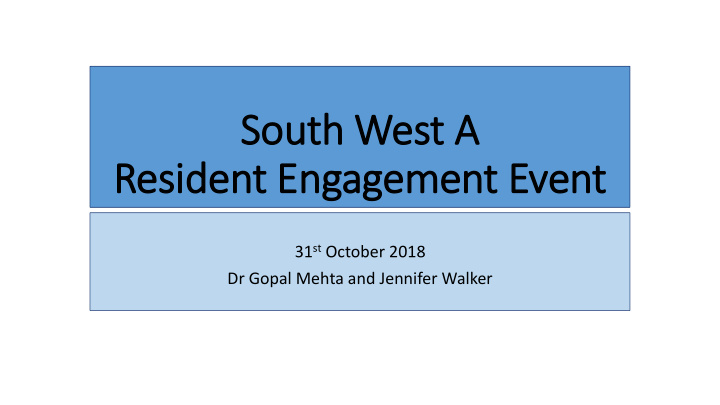



South West A Resident Engagement Event 31 st October 2018 Dr Gopal Mehta and Jennifer Walker
What is a Neighbourhood? “ Where we grow up, and the community we live in, has a massive influence on our health and wellbeing” • GP practices have joined together to form 8 neighbourhoods along with their partners from hospital, community, mental health, social care, housing services, community groups and local voluntary groups. Each Neighbourhood covers a population of around 30-50,000 people. • Practices will work together and with the services listed above to coordinate health and social care for people in their local area, and consider how to make the best and most effective use of local services. • Each Neighbourhood is developing a set of priorities based on the health and social needs of their particular area. There is also a strong focus on preventing ill health, reducing unnecessary hospital admissions and supporting people to gain control of their own health and wellbeing.
What are our Neighbourhoods?
How did we decide on the areas? • Looked at and explored a number of options • Ward boundaries • Local communities • GP registered populations • Children Centres • Used national evidence of what has worked in other places • Using GP practice populations as way of making the neighbourhoods offered a number of advantages • However… • This will be reviewed • We don’t want to split community groups and will work out which neighbourhood will be the lead if they are split • We are going to work with local councillors to make a strong link between wards and neighbourhoods
Why do we need Neighbourhoods? • There is an 7% difference between number of under 5 year olds registered at GPs between the two most different neighbourhoods? • 4.9% SW2 and City • 12% NE1 • Did you now SE1 has the largest percentage of over 65 registered with GP Did you • But even more significant variation by practice (Sorsby 12% and Trowbridge c. 2%) • On the index of social deprivation there is also variation between know? neighbourhoods • SE2 highest (well above London and England average) and NW2 and SW2 + City lowest (but still above London and England average) • NE2 has the highest prevalence of diabetes of all neighbourhoods but also the largest percentage of adults registered as obese • More housebound patients in NW2 and NE2 than in the other neighbourhoods • Social isolation higher in SE1 and SE2 than in the other neighbourhoods
One size/approach doesn’t fit all - Neighbourhoods allow targeted approaches • Significant variations in need across different areas • Deprivation much more significant in Hackney Wick Ward than in Stoke Newington Ward Opportunities to improve outcomes by working at a local level – Neighbourhoods allow opportunity to test approaches in areas of highest need • Hackney performs less well than the London average across a range of life course indicators • Immunisations at 12 months and 5 years • Childhood obesity • Adult smokers, adult binge drinking and deaths from drug overdose • Male life expectancy • Uptake of flu vaccinations Evidence from Safeguarding Adult Reviews – Neighbourhood Teams can create trust, collaboration and improved communication •Recent safeguarding adult reviews have shown a common theme relating to the need to improve “interagency working and communic ati on” Importance of work to improve population health – Neighbourhoods offer a framework to promote and deliver prevention work at a local level • City and Hackney is committed to improving health outcomes and reducing health inequalities while there is increasing demand on public services while spending is being squeezed • Investment in prevention can have a range of impacts which help meets these goals while managing these pressures
What changes/differences can you expect to see as a resident? • Local health (including mental health) and social care teams • More joined up care • Less repetition • Improved communication across teams • Plans agreed with residents • Better access to services outside of health and social care • Increased peer support • Local volunteering • Condition specific support • Potential for more (needs driven) localised services
Teams within Neighbourhoods will… Identify and Work together nurture local to improve staff leadership experience Communicate Work together to focus on prevention well across and broader organisational determinants of boundaries heath Work effectively Understand and Use evidence Empower and and focus on what and good listen to local collaboratively their population practice well residents together needs
Why are we holding this event? We want to know what This will help us understand matters to you as residents in the potential gaps we have your area It will also help us to share You use and experience the information about what we’re services we provide and doing better with you and on understand the area you live in the things that matter to you What you tell us that will help And you can then shape how us shape the priorities for the services are delivered in the work we are doing and we can local area feed it into the local leaders
Some questions for you… What other ways do you think we could get What are the best ways residents views on the of feeding back area they live in? information to you about what we’re doing?
Any questions/more information • If you’d like to get more involved with neighbourhoods, there are lots of opportunities • Email • Emily@healthwatchhackney.co.uk • If you’d like more information about neighbourhoods • Email • Jennifer.walker9@nhs.net
Recommend
More recommend